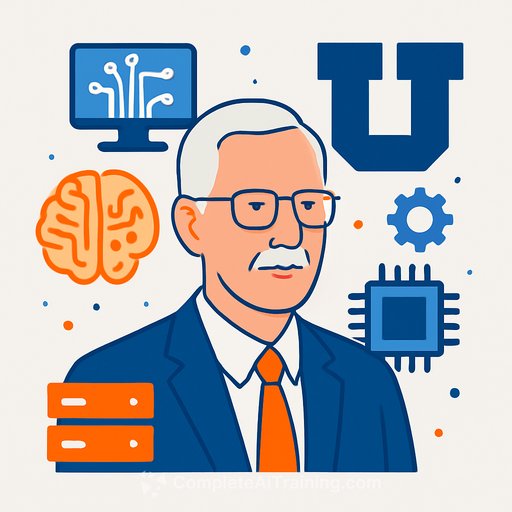Bill Miller brings national expertise to advance research computing and data at the U
Artificial Intelligence
October 14, 2025
After more than a decade advancing cyberinfrastructure at the U.S. National Science Foundation (NSF), William L. (Bill) Miller has joined the University of Utah as senior director for research computing and data. His mandate: accelerate computational and data-enabled research across campus and the region.
Miller will also lead the Center for High Performance Computing (CHPC), which provides large-scale computing systems, expert guidance, and secure environments for thousands of researchers. The appointment underscores the university's commitment to AI, research, and innovation at scale.
Why this matters for researchers
AI has been a university priority since October 2023, when President Taylor Randall launched the $100 million One-U Responsible AI Initiative at the Scientific Computing and Imaging (SCI) Institute. Since then, leaders have expanded partnerships and capacity, including CHPC upgrades in spring and a recent $50 million partnership with Hewlett Packard Enterprise and NVIDIA.
"We are extremely excited to have Bill join us-he brings extensive experience from his previous roles, where he led the development and oversight of large-scale research infrastructure and initiatives at the national level," said Manish Parashar, chief AI officer for the university and director of the SCI Institute, which includes CHPC. "We look forward to his vision and leadership as we deploy advanced cyberinfrastructure in support of Utah's AI innovation ecosystem."
Miller's focus
"I am very excited to begin this new leadership role and look forward to working with my colleagues to grow the university's support for computational and data-intensive research and innovation across campus, the state, and regionally," Miller said. He plans a holistic approach: major expansion of AI infrastructure-compute, data, networking, and software-paired with workforce development for technologists, researchers, and students.
- Scale GPU and CPU resources, storage, and secure research environments
- Advance data services for curation, sharing, and reuse
- Strengthen networking and software stacks for AI and data-intensive workflows
- Expand expert consulting, training, and collaboration opportunities
- Connect campus to national resources and programs
Experience that bridges science, policy, and practice
Miller earned a bachelor's degree in aerospace engineering from the University of Michigan and started his career in scientific space mission development at NASA and in Europe. He later completed a Ph.D. in neuroscience at the University of California, Davis, and conducted experimental research using electrophysiology and non-invasive brain imaging at the University of California, San Francisco, and abroad.
In 2008, he joined NSF as a science and technology policy fellow and progressed through federal roles, including program officer in the Directorate for Biological Sciences and acting deputy head of the Office of Budget, Finance and Award Management. As senior advisor in the Office of Advanced Cyberinfrastructure, he helped craft national strategies, launched the National AI Research Resource (NAIRR) pilot, and advanced open science and research infrastructure efforts across agencies.
His work has crossed domains and borders, including leading the U.S. delegation to the G7 International Open Science Working Group and serving as senior technical advisor to the Department of Energy on detail from NSF. These experiences position him to strengthen university collaborations with academia, industry, and government partners.
For context on the NAIRR pilot, see the program overview at nairrpilot.org. For federal open science policy, review OSTP guidance on public access to research outputs here.
CHPC momentum and what's next
CHPC was previously led by Thomas Cheatham, who returned full-time to his tenured role in the College of Pharmacy's Department of Medicinal Chemistry. Under his leadership, CHPC's user base at the U and beyond doubled and diversified, a trend expected to continue under Miller.
"It is really the perfect time to move quickly and strategically to advance research computing and data for our researchers and educators in this moment of disruption and change in the national scientific enterprise," Miller said. "The SCI Institute and CHPC are right at the center of transforming this vision into action-through technology together with an extremely strong and dedicated team of professionals who work closely with researchers and stakeholders at SCI, University of Utah Health and across the colleges."
What researchers can expect
- Faster access to compute and storage for AI, simulation, and data science
- Improved support for sensitive data and compliance-driven workflows
- More training, office hours, and collaborative project support
- Stronger links to national facilities and programs
- Emphasis on open, reusable data and reproducible methods
Upskilling your research team
If you're planning lab-wide AI adoption or skilling plans, explore curated programs by role and certification tracks to accelerate readiness: AI courses by job and popular AI certifications.
Media & PR contacts
Kelly Hermans
Communications Manager
Scientific Computing and Imaging (SCI) Institute
(706) 296-8037
kelly.hermans@utah.edu
Your membership also unlocks:






